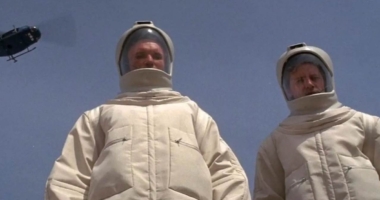“The X-Files” is a popular show that has inspired many other TV shows and movies. The show has also been the subject of spin-offs, including “Millennium,” which starred Lance Henriksen, and “The Lone Gunmen,” which featured a trio of fan-favorite characters. “Final Destination” was another popular movie that was created by “X-Files” alums Glen Morgan and James Wong. Despite the show’s attempts to create spin-offs and pass the torch to other agents, “The X-Files” has never quite become a larger franchise. However, Chris Carter hasn’t given up hope and has been working on other “X-Files” projects. “The X-Files: Albuquerque” is one such project, an animated series about a group of agents that work on strange and boring cases. Although Gillian Anderson is out, David Duchovny has expressed interest in returning, which could lead to the possible return of Mulder in animation.
The X-Files: A Unique and Influential Sci-Fi Show
“The X-Files” is a one-of-a-kind genre show that boasts a rich history of its own. The series has been widely popular, featuring an intriguing blend of monster-of-the-week episodes and a grand, galaxy-altering mythology. Starring David Duchovny and Gillian Anderson as FBI Special Agents Fox Mulder and Dana Scully, the show was ahead of its time in its approach to serialized genre television. It served as an interesting bridge between shows that focused on standalone episodes and those that did not. With nine seasons on television and a feature film in between, the series was briefly revived on the big screen in 2008 and again for a shorter two-season run less than ten years later.
More than anything, “The X-Files” encouraged viewers to believe in something bigger, to connect the dots that they would otherwise have ignored, and to fight the future if it’s worth fighting. While there are countless reasons why fans love Mulder, Scully, and the rest of the gang, there are a few interesting tidbits that viewers may not know.
Long before “The X-Files” became a reality, the series creator, Chris Carter, drew inspiration from the short-lived supernatural show, “Kolchak: The Night-Stalker.” Played by Darren McGavin, Kolchak was an investigative journalist for Chicago’s INS who specialized in reporting on the strange and inexplicable. He covered everything from vampires and werewolves to robots and aliens. Carter eventually developed a “Kolchak”-esque series which eventually became “The X-Files.” In an interview with New York Daily News, Carter admitted that his goal was to create a show that was even scarier than “The Night-Stalker.” Over the years, many “Kolchak” references made it onto “The X-Files,” including casting McGavin as former FBI agent Arthur Dales, the man who started the X-Files in the 1960s and Mulder’s source of inspiration.
In the episode “Mulder & Scully Meet The Were-Monster,” the titular creature, when disguised as “Guy Mann,” dresses just like the ’70s reporter, right down to the trademark hat and suit. Such references are a testament to the enduring influence of “Kolchak: The Night-Stalker” on “The X-Files.”
In summary, “The X-Files” is an influential sci-fi show that has left its mark on popular culture. From its unique blend of standalone episodes and grand mythology to its use of “Kolchak: The Night-Stalker” as an inspiration, the series has captivated audiences and encouraged them to believe in something bigger.
The X-Files: Duchovny’s Exit and William B. Davis’ Skepticism
As “The X-Files” approached its seventh season, David Duchovny believed that his time as Fox Mulder had come to a close. The season was designed to be the show’s final hour, wrapping up Mulder’s storyline regarding his sister’s abduction, deepening his relationship with Scully, and ending the alien mythology tale. It even started and ended with Mulder and Scully’s very first X-File. When the series was renewed, it was unclear where “The X-Files” would go next, and Duchovny decided to leave. He was replaced by Robert Patrick’s Agent John Doggett, but Duchovny still appeared in the final two seasons, appearing in 12 of the 21 episodes in Season 8 and returning for the two-part series finale and future films and seasons.
William B. Davis played the infamous Cigarette Smoking Man, who was responsible for some of the most sinister conspiracies on “The X-Files.” Despite being a fan-favorite character, Davis had no interest in the paranormal. He’s a skeptic and is proud of it. Davis has spoken at numerous conferences that highlight skeptical ideas, and he attributes his skepticism to the Committee for Skeptical Inquiry. In an interview with The A.V. Club, Davis explained that it’s up to believers to prove that things like the paranormal exist and not the other way around. Davis has even hosted a docuseries called “Critical Eye,” which aimed to debunk apparent paranormal occurrences.
In summary, David Duchovny’s exit from “The X-Files” was a significant change that could have affected the series. However, Duchovny was still involved in the final two seasons, and his character Mulder remained a vital part of the show’s story. Similarly, William B. Davis’ portrayal of the Cigarette Smoking Man added a significant layer to the series, despite his personal skepticism regarding the paranormal.
The Truth is Out There: Science and Truth in “The X-Files”
“The X-Files” is known for its outlandish conspiracies and paranormal phenomena, but there’s more truth to the series than meets the eye. The show touched on real-life events and science, making it a compelling watch for fans of the genre. Since the revival series ended, the Pentagon has released hundreds of UFO reports, and some officials now theorize that an alien mothership may be observing us from the other end of the galaxy.
“The X-Files” highlighted government secrets in episodes like “Paper Clip,” which delved into Operation Paperclip, a government project that conscripted Nazi scientists to work for the United States after World War II. “The Pine Bluff Variant” saw Mulder infiltrating a terrorist cell that turned out to be a cover for a government bioweapons test, which is not too far off from the FBI paying informants to incite potential terrorists to criminal activity.
While the show is fictional, the writers consulted with scientific consultants, including University of Maryland microbiologist Anne Simon and Canadian virologist Margaret Fearon, to make the science behind the paranormal phenomena more realistic. The pilot episode’s phrasing and terminology were informed by showrunner Chris Carter’s brother, who is a professor at MIT. Following the original run’s conclusion, Simon wrote a book entitled “The Real Science Behind The X-Files,” providing scientific explanations for the paranormal phenomena in the series.
In conclusion, while “The X-Files” is known for its fictional and outlandish storylines, there is a lot of truth woven throughout the series. From government secrets to scientific validity, the show tackled real-life events and phenomena, providing a compelling watch for fans of the genre.
Stephen King and His Influence on The X-Files
While Stephen King may not have been the sole author of an episode of “The X-Files,” his impact on the show’s storytelling cannot be denied. The horror author co-wrote the episode “Chinga,” which, unfortunately, wasn’t as well-received as King had hoped, and is often cited as one of the show’s early missteps. Nevertheless, his episode has become infamous and adds to the allure of the show’s supernatural themes.
King himself was a fan of “The X-Files,” and it was through his own initiative that he was able to collaborate with the show. According to Andy Meisler’s “Resist or Serve: The Official Guide to The X-Files, Vol. 4,” King reached out to David Duchovny, and eventually, series creator Chris Carter hired the author to pen a single episode.
Dana Scully: Influenced by Clarice Starling?
Gillian Anderson’s portrayal of FBI Agent Dana Scully in “The X-Files” has made a significant impact on the entertainment industry. However, it’s interesting to note that her character may have been influenced by a particular character from another popular franchise. As Carter commented in Smithsonian Magazine, “it’s not a mistake that Dana Scully has red hair like Clarice Starling,” referring to Jodie Foster’s character from “The Silence of the Lambs.”
However, while Scully’s work at the FBI and her drive to catch serial killers and monsters have similarities with Foster’s character, the idea for Scully came from a combination of Carter’s religious background and his interest in science. This influence helped to create a well-rounded character that has become an iconic figure in pop culture.
Conclusion
“The X-Files” is a cultural phenomenon that has captured the imaginations of viewers worldwide. With collaborations with renowned authors like Stephen King and the creation of characters like Dana Scully, the show has cemented its place in television history. Even years after its original run, it continues to captivate audiences with its thrilling storytelling and supernatural themes.
“The X-Files” Post-Revival: What Happened?
“The X-Files” took a six-year hiatus after its original finale in 2002 until the release of its second feature film in 2008, “The X-Files: I Want to Believe.” Many fans hoped for a return to the alien mythology story, but the film told a standalone X-File. Following the film’s release, series creator Chris Carter expressed his interest in revisiting the mythology in a third feature, mentioning the important date in the show’s mythology of 2012. David Duchovny and Gillian Anderson also expressed hopes for a continuation of the alien plot, but by 2014, Anderson no longer believed the invasion date was relevant.
In 2016, Fox announced a six-episode event series, with Duchovny and Anderson reprising their roles as Mulder and Scully. The revival seasons combined monster-of-the-week episodes with a longer arc, which mirrored the show’s earliest and most successful seasons. However, the revival didn’t receive as much critical acclaim as the original series.
Prior to the revival’s release, “The X-Files” was at a standstill, with the long-awaited third movie stuck in development hell. In 2013, IDW released “The X-Files: Season 10,” a comic book series written by Joe Harris and “executive produced” by Chris Carter. The comics continued plot threads established in the show’s initial run, including the impending alien invasion and why Earth wasn’t invaded after all. The series was well-received, and the plot was treated with more respect than the revival.
The comic book series continued for 11 seasons and ended with a 8-issue arc, “The X-Files: Season 11,” which coincided with the revival’s release. Many of the comics’ arcs were adapted as Audible Originals, with Duchovny and Anderson reprising their roles. Though the Audible Originals have since been removed from the platform, the comics can still be found online.
Despite mixed reception, “The X-Files” revival was a unique opportunity for fans to reunite with Mulder and Scully and relive their supernatural adventures.
“Millennium” and Frank Black
Chris Carter, the creator of “The X-Files,” had another dark show called “Millennium,” which followed the story of former FBI profiler Frank Black (played by Lance Henriksen) and his family after he joins a doomsday cult. Although the show was profoundly different from “The X-Files,” there were a few crossovers between them. Unfortunately, the show was canceled after its third season, but Frank’s story concluded in “The X-Files” Season 7 episode “Millennium.” Writer Joe Harris also resurrected the character for an arc in the “The X-Files: Season 10” comic book, which spawned a five-issue “Millennium” limited series.
“The Lone Gunmen”
In 2001, Bruce Harwood, Dean Haglund, and Tom Braidwood, who portrayed the recurring characters of Byers, Langly, and Frohike, starred in a short-lived series called “The Lone Gunmen.” The show was a blend of mystery and comedy and followed the trio’s adventures to expose the nation’s darkest and most well-kept secrets. The most notable episode of the show was the pilot, which featured the Gunmen foiling the plot of rogue government operatives who attempted to crash a plane into the World Trade Center. The episode premiered six months before the 9/11 terrorist attacks and bore similarities to some of the conspiracy theories about them. Unfortunately, the ratings plummeted, forcing the trio to finish off their arc back on “The X-Files.”
The X-Files: A Source of Inspiration for Other Projects
“The X-Files” has had a profound impact on popular culture, inspiring several other movies and television shows. Here are a few notable examples:
Final Destination
Breaking Bad
“Breaking Bad” was also influenced by “The X-Files.” After joking about starting a meth lab in a Winnebago and traveling throughout the Southwest, “X-Files” writer Vince Gilligan began to imagine Walter White, the character who would become the protagonist of “Breaking Bad.” Bryan Cranston, who had previously guest-starred in a “X-Files” episode written by Gilligan, was cast as the lead.
Supernatural
“Supernatural” is a series that shares many similarities with “The X-Files.” Director/producer Kim Manners, who worked on “The X-Files” for years, joined the show, as did several other crew members.
Gillian Anderson and David Duchovny
After playing Dana Scully for nearly two decades, Gillian Anderson confirmed that her tenure on “The X-Files” had come to an end. Though Anderson has no plans to return, David Duchovny has stated that he’d be open to reprising his role as Mulder if the right story were to come along.
Chris Carter, creator of “The X-Files,” is reportedly working on new projects for the franchise. In 2020, an animated series called “The X-Files: Albuquerque” was announced, featuring a new group of agents working on cases deemed too weird or boring for traditional teams. While there hasn’t been much news on the project since Disney acquired Fox, it is reportedly still in development. David Duchovny has expressed interest in returning to the franchise, so it’s possible we could see Mulder again, even if Gillian Anderson is not involved.
Don’t miss interesting posts on Famousbio










